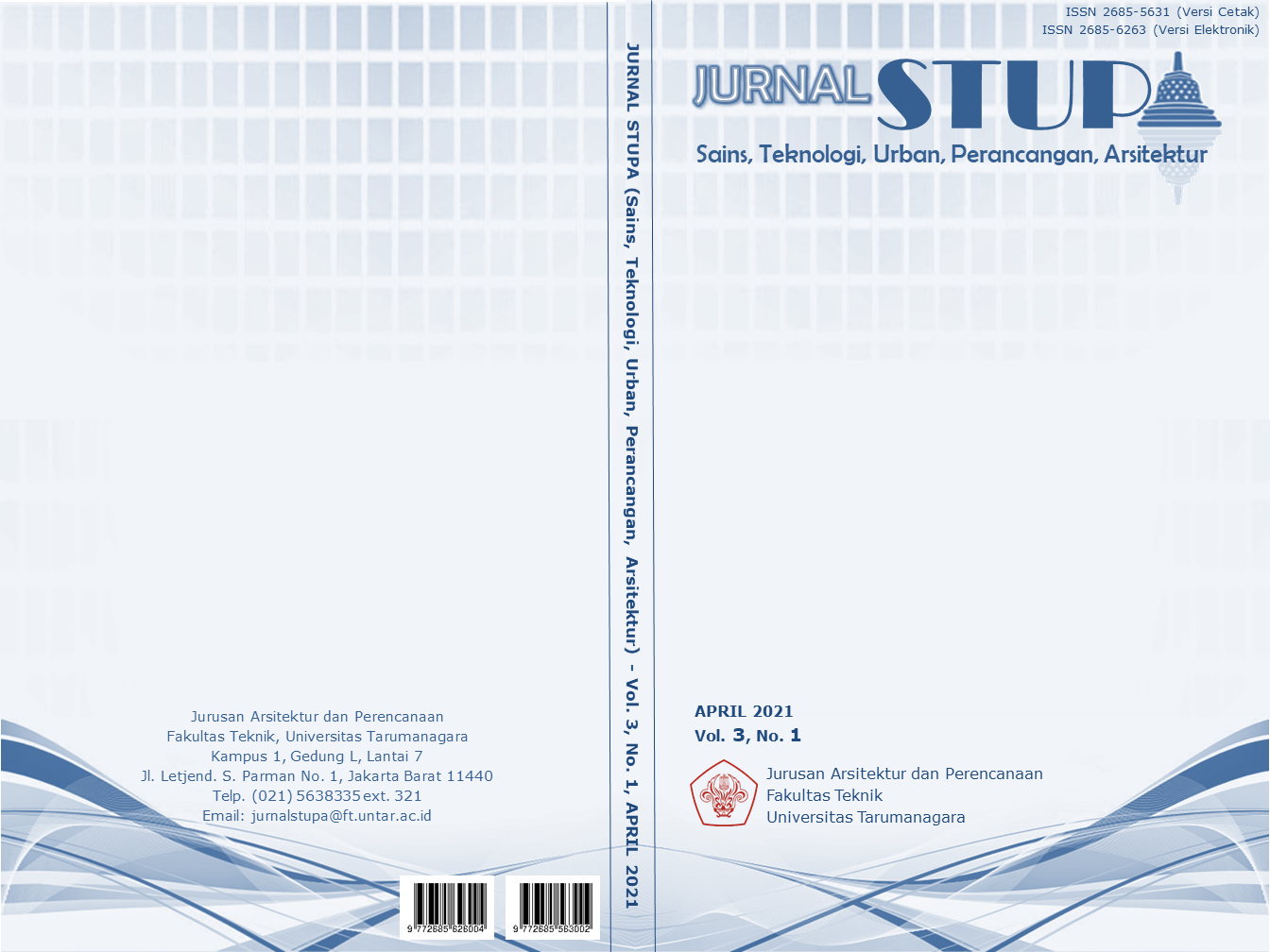EKSPLORASI DESAIN TAMAN DENGAN PENDEKATAN BIOFILIK BERBASIS ETIKA LINGKUNGAN DI BSD
Isi Artikel Utama
Abstrak
Ethical Biophilic Park in BSD, Tangerang Is a connected open green spaces between a green park and a deer park., which one has existing faunal element specifically deer. Located at Jakarta’s suburban area, BSD Biophilical Park is one of many parks that foster a herd of deer. Both sites were found not maximized in their function, the existing deer foster has not considered fulfilling five freedoms of animal welfare, which must looked at into more in the future. Conceiving the needs of the human-animal interaction, biophilic and rewilding design methods are expected to be sufficient for the welfare of both parties. The park allocates a variety of artificial natural elements, closeness to faunal elements, as well as space experiences in enclosed spaces. Observing on how the park treat the herd, and how it affects the human activity, creates an output of a green park, that is still connected with the deer park, and also ones which has a full-length trail to see the herd without direct interaction such as petting and. In addition to the design, it involuntarily comply environmental ethics that favor the following welfare of the animal itself.
Keywords: Biophilical Park; Deer Fostering; Environmental Ethics; Opened Green Public; Space Rewilding
Abstrak
Taman Biofilik Berbasis Etika Lingkungan di BSD merupakan perpaduan dua ruang terbuka hijau yang salah satunya memiliki unsur fauna berupa rusa. Terletak di daerah sub urban Jakarta, Taman Biofilik BSD merupakan satu-satunya taman yang merawat rusa. Kedua tapak ditemukan belum maksimal dalam fungsinya, pemeliharaan rusa juga dianggap belum memenuhi lima unsur kesejahteraan hewan, yang kedepannya harus lebih diperhatikan. Memahami kebutuhan adanya hubungan dan interaksi antara manusia dan hewan, metode desain biofilik dan untuk diliarkan diharapkan dapat mencukupi kesejahteraan bagi kedua pihak. Taman mengalokasikan berbagai unsur alam buatan, kedekatan dengan unsur fauna, serta pengalaman ruang yang bersifat lebih terbuka atau tidak sepenuhnya terbangun dinding empat sisi. Mengamati perlakuan taman eksisting pada hewan, dan pengaruh aktivitas manusia didalamnya, menghasilkan taman manusia yang tetap terintegrasi dengan taman rusa, yang didalamnya terdapat jalur untuk melihat-lihat rusa tanpa secara langsung memegang atau memberi makan rusa. Terapan desain secara tidak langsung menghasilkan interaksi yang mematuhi etika lingkungan yang kerap mempengaruhi kesejahteraan hewan itu sendiri.
Rincian Artikel
Referensi
A. Benton, M. Kwaku, and Z. Zhaohua. (2010). Global rattan programme. Retrieved January 16, 2021, from International Network for Bamboo and Rattan (INBAR): http://www.inbar.int/Board.asp?BoardID=101.
ADFG Alaska. (n.d.). Mule Deer (Odocoileus hemionus). Retrieved January 13, 2021, from https://www.adfg.alaska.gov/index.cfm?adfg=muledeer.printerfriendly
Adriyan, D., R. (2018). Fenomena Pembonceng Gratis (Free Riders) di Sekitar Kota Baru Bumi Serpong Damai (BSD City). Tata Loka, 20(4), 364-365.
Ashihara, Y.. (1970). Exterior Design in Architecture. New York: Van Nostrand Reinhold.
Brown University. (2008). Internalized Authority and the Prison of the Mind: Bentham and Foucault's Panopticon. Retrieved August 6, 2020, from Brown.edu: https://brown.edu/Departments/Joukowsky_Institute/courses/13things/7121.html
Browning, W. et al. (2014). Biophilic design patterns & Biological Responses. In 14 Patterns of Biophilic Design. New York: Terrapin Bright Green LLC.
Canton, J. (2009). The Extreme Future. (Ed).Ade Fakih Kurniawan. Tangerang Selatan: Pustaka Alvabet
Dindaq. (2014). Etika Lingkungan Hidup. Retrieved January 13, 2021, from http://diditnapa.blogspot.com/
Frumkin, H. (2017). Nature Contact and Human Health: A Research Agenda. Environmental Health Perspectives, 125(7).
Heerwagen, J.H. , G.H. Orians. (1993). Humans, Habitats and Aesthetics. In: S.R. Kellert & R.S. Wilson, The Biophilia Hypothesis (138-172). Washington: Island, 484.
Indian Architect & Builder. (2015). Juhani Pallasmaa on Writing, Teaching and Becoming a Phenomenologist. Retrieved January 17, 2021, from archdaily.com: https://www.archdaily.com/776761/juhani-pallasmaa-on-writing-teaching-and-becoming-a-phenomenologist
Indo Pet Expo. (2018). The Five Freedoms of Animal Welfare. Retrieved Januari 13, 2021, from http://indopetexpo.id/articles/five-freedoms-animal-welfare/
Kellert, S.R et al. (2009). Biophilic Design: The Theory, science, and practice of bringing building to life. Hoboken, NJ: John Wiley & Sons,Inc.
Kellert, S.R. & Wilson, E.O. (1993). The biophilia hypothesis. D.C.: Island Press.
Leeuwen, H. van. (1980). Ecologie van het wonen. The Hague: Vuga.
Marfai, M. A. (2019). Pengantar Etika Lingkungan dan Kearifan Lokal. Yogyakarta: Gadjah Mada University Press.
Navarro LM, Pereira HM. (2012). Rewilding abandoned landscapes in Europe. Ecosystems, 15(6):900–12.
Rapoport, A. (1995). A Critical Look at the Concept 'Home'. In D. N.
Benjamin, D. Stea, & E. Are?n, The home: words, interpretations, meanings and environments (pp. 25-52). Avebury: Aldershot.
Roo, M. (2011). The Green City Guidelines: Techniques for a liveable city [Guidelines]. UK: UK Green Forum.
Santosa, Y. et al. (2008). Pendugaan Model Pertumbuhan dan Penyebab Spasial Populasi Rusa Timor di Taman Nasional Alas Purwo Jawa Timur. Media Konservasi, 13(1), 5.
SER. (2004). SER International Primer on Ecological Restoration. Tucson: Society for Ecological Restoration International.
Serres, M. with Latour, B. (1995). Conversations on Science, Culture, and Time. Ann Arbor : The University of Michigan Press.
Sulistiono, R. (2013). Etika Lingkungan. Retrieved January 13, 2021, from http://rovisulistiono.blogspot.com/2013/10/etika-lingkungan.html
Tjahjono, G.. (2000). Metode Perancangan Suatu Pengantar untuk Arsitek dan Perancang. Jakarta: Universitas Indonesia.
Tsunetsugu, Y., Y. Miyazaki, & H. Sato. (2007). Physiological Effects in Humans Induced by the Visual Stimulation of Room Interiors with Different Wood Quantities. Journal of Wood Science, 53 (1), 11-16.
UNEP, U. A. (2001). World Conservation Union. In P. James Canton, The Extreme Future: The Top Trends That Will Reshape the World (pp. 190-191). New York: Penguin Group.
Vitztum, Coley RN, MSN, CCNS. (2013). Human–Animal Interaction: A Concept Analysis. International Journal of Nursing Knowledge, 3.
Watson, Ri. (2008). Future Files: 5 trends that will shape the next 50 years. London: Nicholas Brealey Publishing.
Wilson, E. O. (1984). Biophilia. Cambridge, MA: Harvard University Press, ISBN 0-674-07442-4.
Young, C. et al. (2020). Psychological restoration in urban gardens related to garden type,biodiversity and garden-related stress. Landscape and Urban Planning, 198, 7-8.



